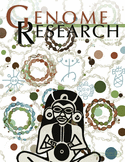ABySS 2.0: resource-efficient assembly of large genomes using a Bloom filter
- Shaun D. Jackman1,
- Benjamin P. Vandervalk1,
- Hamid Mohamadi,
- Justin Chu,
- Sarah Yeo,
- S. Austin Hammond,
- Golnaz Jahesh,
- Hamza Khan,
- Lauren Coombe,
- Rene L. Warren and
- Inanc Birol
- Canada's Michael Smith Genome Sciences Centre, British Columbia Cancer Agency, Vancouver, British Columbia, V5Z 4S6, Canada
- Corresponding author: ibirol{at}bcgsc.ca
-
↵1 These authors are joint first authors and are listed in alphabetical order.
Abstract
The assembly of DNA sequences de novo is fundamental to genomics research. It is the first of many steps toward elucidating and characterizing whole genomes. Downstream applications, including analysis of genomic variation between species, between or within individuals critically depend on robustly assembled sequences. In the span of a single decade, the sequence throughput of leading DNA sequencing instruments has increased drastically, and coupled with established and planned large-scale, personalized medicine initiatives to sequence genomes in the thousands and even millions, the development of efficient, scalable and accurate bioinformatics tools for producing high-quality reference draft genomes is timely. With ABySS 1.0, we originally showed that assembling the human genome using short 50-bp sequencing reads was possible by aggregating the half terabyte of compute memory needed over several computers using a standardized message-passing system (MPI). We present here its redesign, which departs from MPI and instead implements algorithms that employ a Bloom filter, a probabilistic data structure, to represent a de Bruijn graph and reduce memory requirements. We benchmarked ABySS 2.0 human genome assembly using a Genome in a Bottle data set of 250-bp Illumina paired-end and 6-kbp mate-pair libraries from a single individual. Our assembly yielded a NG50 (NGA50) scaffold contiguity of 3.5 (3.0) Mbp using <35 GB of RAM. This is a modest memory requirement by today's standards and is often available on a single computer. We also investigate the use of BioNano Genomics and 10x Genomics’ Chromium data to further improve the scaffold NG50 (NGA50) of this assembly to 42 (15) Mbp.
Footnotes
-
[Supplemental material is available for this article.]
-
Article published online before print. Article, supplemental material, and publication date are at http://www.genome.org/cgi/doi/10.1101/gr.214346.116.
-
Freely available online through the Genome Research Open Access option.
- Received August 7, 2016.
- Accepted February 14, 2017.
This article, published in Genome Research, is available under a Creative Commons License (Attribution 4.0 International), as described at http://creativecommons.org/licenses/by/4.0/.










